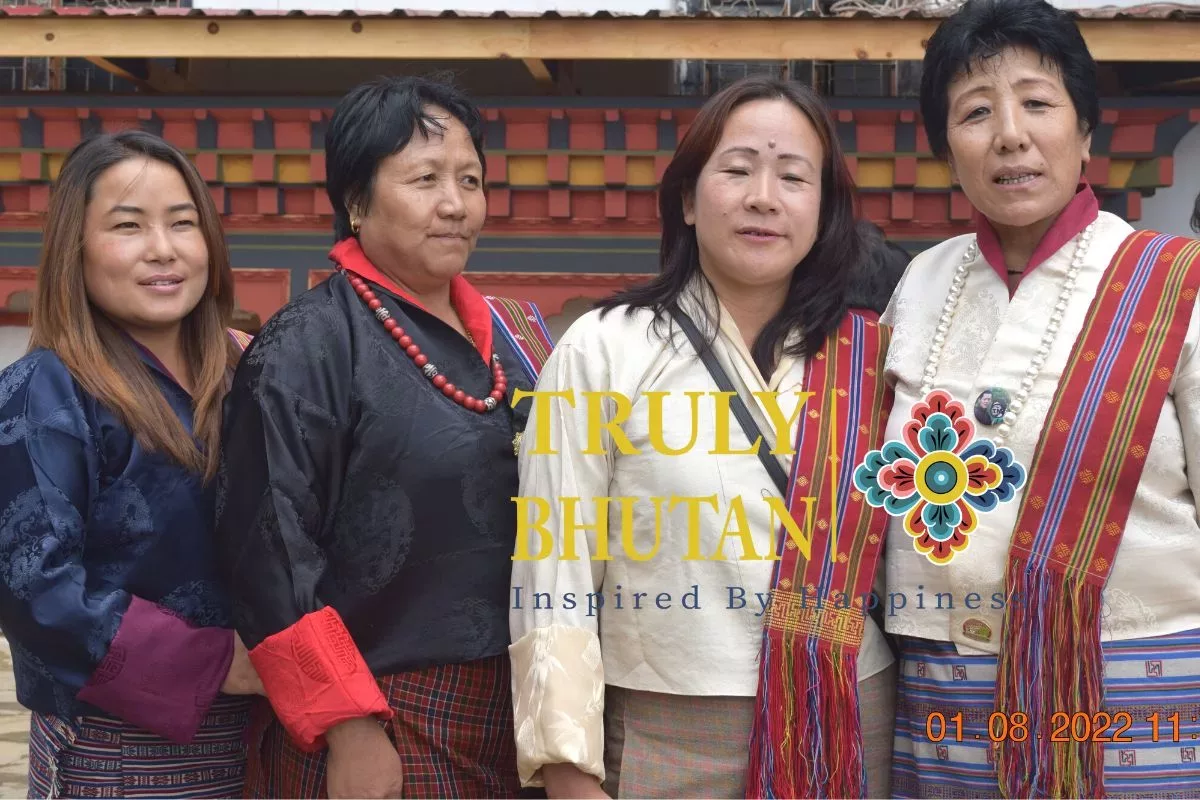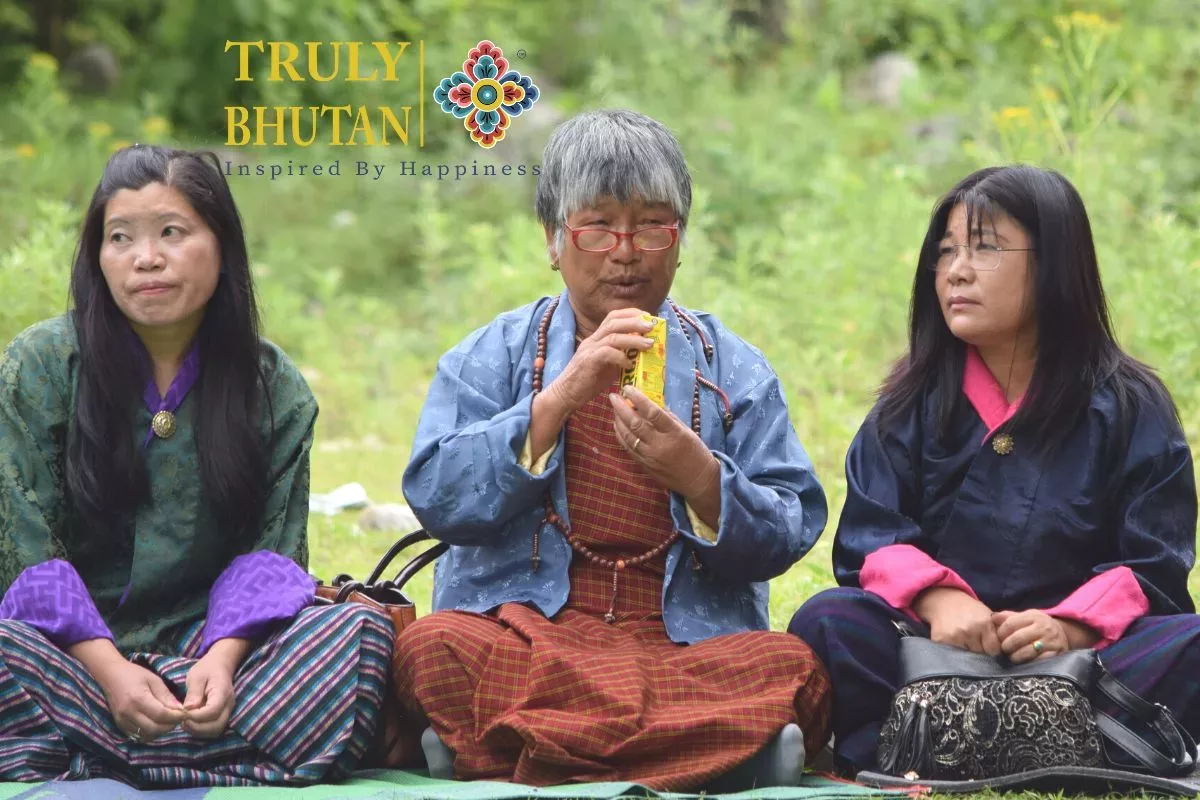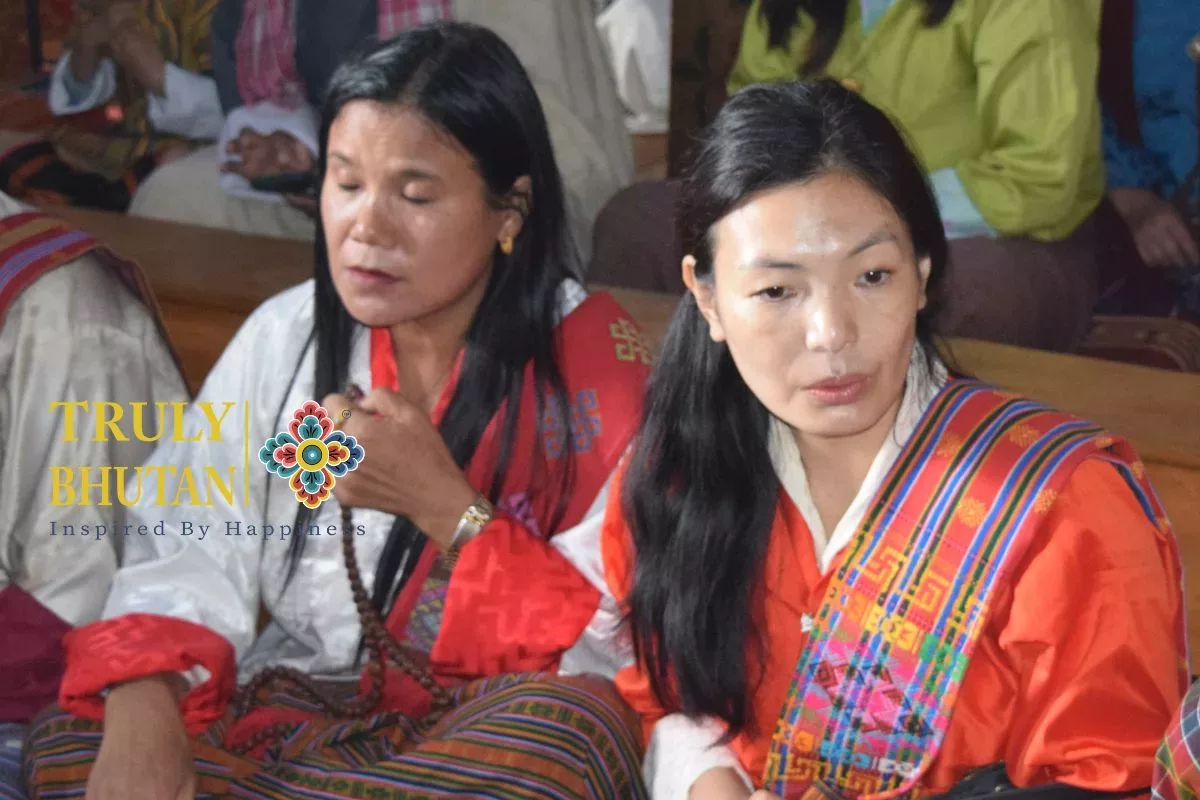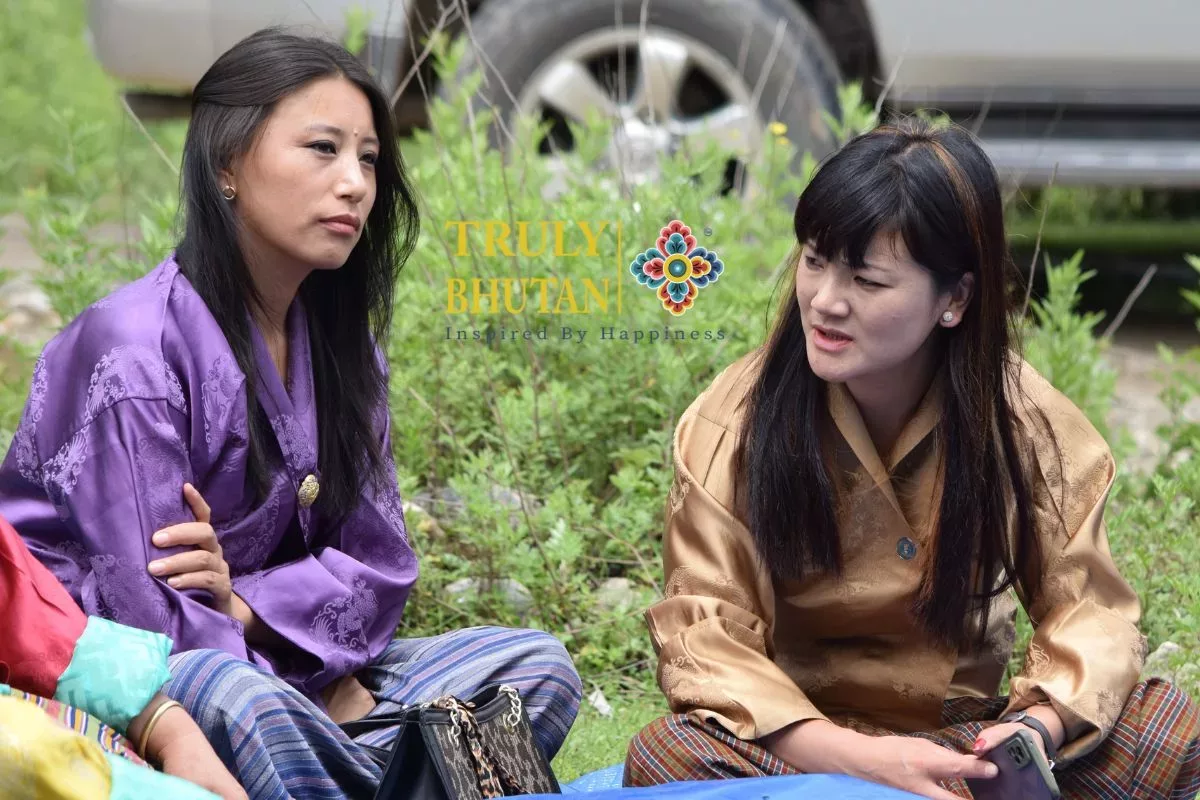Detailed Program
Our Team from Truly Bhutan will receive you at the airport with Tashi Khadar and drive you a short distance to the hotel. After Tea, visit to the watch tower of Paro Dzong which now houses the National Museum. The museum is an important center for the preservation of Bhutanese artifacts, culture, and history.
Then, we continue to Rinpung Dzong (or Paro Dzong), which means “the fortress of the heap of jewels.” This complex houses the administrative and religious headquarters for the Paro district. A part of Bernardo Bertolucci’s movie, “Little Buddha,” was filmed inside this Dzong.
From the Dzong, we will enjoy a short and easy walk to the Pachu River and cross to the other side over a traditional cantilever (wooden covered) bridge after lunch Drive to Drukgyel Dzong, a ruined fortress that is 16 km away from Paro Town. Although in ruins, this Dzong is of great historical importance. It was here that the Bhutanese finally defeated the invading Tibetans and drove them back. From here, the peak of Jumolhari’s Mountain of the Goddess can be seen on a clear day (Alt. 7,329 m /24,029 ft.).
And on the way back visit Kichu Lhakhang the oldest and the most sacred shrine of Bhutan built in the 8th century by the Tibetan King Songtsen Gampo. In the evening take a stroll in Paro town.
Places and attractions:
- Rinpung Dzong
- Drukgyel Dzong
- Taktshang
- Kyichu Lhakhang
- Kila Gompa
- Dungtse Lhakhang
- Tachog Lhakhang
- Dzongdrakha
Accommodation options:
After breakfast drive to Thimphu and visit the National Memorial Chorten (1974) built in honor of our late King Jigme Dorji Wangchuk, “The Father of Modern Bhutan”. Built in a typical Tibetan style, there are numerous religious paintings and complex tantric statues reflecting both the peaceful and wrathful aspects of Buddhist deities. This Chorten is also a center of worship for the people living in Thimphu.
Then visit Dupthob Lhakhang one of the few surviving nunneries in Bhutan. Visit Changkha Monastery (This monastery was built in the 15th century by the lama Phajo Drugom Zhigpo) where the newborn children of Thimphu valley are taken to receive 1st blessing from a High Lama. Drive to Mini Zoo where Takin, the national animal of Bhutan can be seen.
This particular animal is found only in the Himalayan region and the head of this animal looks like that of a goat and the body of a cow/yak before sunset drive to Sangay gang view point (2685 meters) to have a view of the whole Thimphu valley and walk through hundreds of colorful prayer flags that dot the hill overlooking the Thimphu valley.
Dinner and Overnight in Hotel at Thimphu.
Places and attractions:
- Tashichho Dzong
- Semthoka Dzong
- Dochu La Pass
- Memorial Chorten
- Changangkha Lhakhang
- Zangdopelri
- The Tallest Buddha Image
- Tango And Cheri Monasteries
- The Handicrafts Emporium
- Traditional Medicine
- Zorig Chusum Institute
- National Library
- Weekend Market
- Botanical Garden
- Thadrak Goemba
- Tashigang Goemba
- Chizhing Samtencholing Lhakhang
Accommodation options:
After breakfast, visit the National Library, stocked with ancient Buddhist manuscripts, and the Painting School where traditional art is still kept alive through instructions in the art of painting Thankas (sacred Buddhist religious scrolls). We can visit different classrooms, where different students follow a comprehensive course that starts with drawing and progresses through painting, wood and slate curving, and statue making.
Visit Traditional Medicine Institute where medicines are prepared according to ancient practices. Visit Handicraft Emporium for shopping Bhutanese Various Arts and Textiles. After lunch visit, we will hike to Tango Monastery. The trail Tango is a climb of 280 meters and it takes an hour to reach the monastery. Lama Gyalwa Lhanangpa founded the monastery in the 12th century. The “Divine madman” built the present building in the 15th century. This is one of the best places for meditation.
In the evening, visit to the Tashichho Dzong (Fortress of the Glorious Religion). In 1216 the lama Gyalwa Lhanangpa built Dohon (Blue Stone) Dzong on the hill above Thimphu Where Dechen Phodrang now stands. A few years later Lama Phajo Drugom Zhigpo, who brought the Drukpa Kagyu line age to Bhutan, took over Dohon Dzong.
In 1641 the Zhabdrung (The one who unified the country) acquired the dzong from the descendants of lama Phajo and renamed it Trashi Choe Dzong. He then arranged to house both monks and civil officials in the same Dzong. Present it is a seat of the national government and the Central Monastic Body, including the summer residence of the Je Khenpo (Chief Abbot of Bhutan).
Dinner and overnight in Hotel.
Places and attractions:
- Tashichho Dzong
- Semthoka Dzong
- Dochu La Pass
- Memorial Chorten
- Changangkha Lhakhang
- Zangdopelri
- The Tallest Buddha Image
- Tango And Cheri Monasteries
- The Handicrafts Emporium
- Traditional Medicine
- Zorig Chusum Institute
- National Library
- Weekend Market
- Botanical Garden
- Thadrak Goemba
- Tashigang Goemba
- Chizhing Samtencholing Lhakhang
Accommodation options:
After early breakfast, drive to Punakha via Dochula Pass, where you can see 108 Bhutanese Stupas. If the weather is clear you can see all Himalayas Ranges with all snow covered. Further drive to Punakha and visit Punakha Dzong. The Dzong is situated between the two rivers and it is one of the biggest rivers in Bhutan.
We have to walk through the suspension bridge to reach the Dzong. The Dzong was built in 1637 by Zhabdrung Ngawang Namgyal and is situated between Pho Chu (Male River) and Mo Chu (Female River). For many years until the time of the second king, it served as the seat of the Government.
The construction of the Dzong was foretold by Guru Rimpoche, who predicted, “…a person named Namgyal will arrive at a hill that looks like an elephant”. There was a smaller building here called Dzong Chu (Small Dzong) that housed a statue of Buddha. It is said that Zhabdrung ordered the architect, Zowe balep, to sleep in front of the statue, while balep was sleeping; Zhabdrung took him in his dreams to Zangdopelri and showed him the palace of Guru Rimpoche.
From his vision, the architect conceived the design for the new Dzong, which in keeping with the tradition, was never committed to paper. The Dzong was named Druk Pungthang Dechen Phodrang (Palace of Great Happiness). The war materials captured during the battle with Tibetans are preserved here. Punakha is still the winter residence of Je-Khenpo and King Jigme Dorji Wangchuk convened the new national Assembly here in 1952. In the evening short hike to Chimi Lhakhang, Lama Drukpa Kuenley built this in the 15th century.
(This monk is popularly known as the Devine madman for his philosophy, “Salvation through sex”). He subdued the demons with his “Magical Thunder bolt”. The Temple is also known as “The Temple of Fertility”. Sterile women from far and wide come to this Temple to get blessed and an article about this temple also appeared in the newspaper, The Washington Post some years back.
Dinner and overnight in Hotel at Punakha.
Places and attractions:
- Punakha Dzong
- Khamsum Yulley
- Talo Goenpa
- Nalanda Buddhist College
- Chorten Nyingpo Lhakhang
- Sangchen Dorji Lhuendrup
- Limukha Village
- Ritsha Village
Accommodation options:
Early breakfast, drive to Wangdiphodrang, and visit Wangdue Dzong was founded by Zhabdrung in 1639. It is situated on a hill with a commanding view of the valley. It is believed that the protective deity, Yeshey Gonpo told Zhabdrung Rimpoche that if he builds a dzong on the ridge he would be able to bring the whole country under his power. Wangdue means to bring under one’s power. Continue your drive to Gangtey valley. It is one of the most beautiful glacial valleys of the Himalayas. Visit Gangtey Gompa from the outside.
Gyatso Pema Thinley, the grandson and mind reincarnation of Pema Lingpa founded the Temple in 1613, and Tenzin Legpai Dhendup, the second reincarnation, built the temple. The present Abbot, Kunzang Pema Namgyal is the ninth reincarnation. It is a Nyingmapa monastery and is affiliated with other Nyingmapa monasteries including Tamshing in Bumthang. Explore Phobjikha valley, famous for the Black Necked Cranes during winter.
These cranes are very rare and endangered and highly protected by the Government. These cranes fly to the Phobjikha valley which is their winter Habitat. Stop at Chendbji Chorten patterned on Swayambunath temple in Kathmandu. It was built in the 18th century by Lama Shida, from Tibet, to cover the remains of an evil spirit that was subdued at this spot and driven to Trongsa.
Dinner and Overnight in Hotel Yangkhil.
Places and attractions:
Accommodation options:
After breakfast visits Trongsa Dzong, the most impressive dzong in Bhutan, built in its present form in 1644 by Chogyal Minjur Tempa, the official who was sent by Zhabdrung to unify eastern Bhutan and enlarged at the end of the 17th century by Desi Tenzin Rabgay. Trongsa Dzong is the ancestral home of the present Royal Family and the first two hereditary kings ruled Bhutan from this Dzong. Drive to Bumthang via Yutong la Pass and Kilakha Pass.
Bumthang sightseeing includes the Bhutanese Carpet Factory, where they used Yak and Sheep wool and even pure silk to weave different carpets and the Bhutanese Textiles., after lunch visit Jakar Dzong, which means “The Castle of White Bird”. The current structure was built in 1667 and then visits Lamey Goemba, a large palace and monastery built in the 18th century by Dasho Phuntsho Wangdi. Visit Jambay Lhakhang, built by King Songtsen Gampo of Tibet in the year 659 on the same day as Kichu Lhakhang in Paro. The temple was visited by Guru Rimpoche during his visit to Bumthang and was renovated by Sindhu Raja after Guru Rimpoche restored his life force. Under the temple is said to be a lake in which Guru Rimpoche hid several Terma.
In October one of the most spectacular festival, “Jambay Lhakhang Drup” is staged here. visit Kurjey Lhakhang which is named after the body print of Guru Rimpoche, built in 1652 by Minjur Tempa. Visit Tamshing Lhakhang (Temple of the good message), established in 1501 by Pema Lingpa and is the most important Nyingmapa temple in the kingdom. Visit Thangbi Temple, founded by Shamar Rimpoche in 1470, is located amid a buckwheat field.
After a dispute, the temple was taken over by Pema Lingpa from Shamar Rimpoche. It is 17 Kilometers drive north of Kurjey Temple on an unpaved road to Toktu Zampa. You start your walk from here by crossing a small suspension bridge and walk 20 minutes past fields of buckwheat to the Thangbi Temple and overnight at Bumthang.
Places and attractions:
Accommodation options:
Drive to Ugyen Choling Palace built 17 the century by Deb Tsokey Dorji, a descendant of Buddhist Saint Dorje Lingpa. Ugyen Choling is a national treasure, privately owned by the same family for hundreds of years. Its remote location makes it one of the less frequently visited historical sites in Bhutan, hosting fewer than two hundred guests per year. The best part of the Palace is the quaint museum housing permanent exhibits on three floors in the main building and the Utse, the central tower.
Traditional living quarters are recreated to capture the realistic ambiance of the ancient lifestyles and conditions of the households. Everyday kitchen and weaving utensils, war weapons–including petrified yak dung to make gunpowder–tools, and farming implements are the main part of the exhibits. On the way back from Tang you can stop to see Shemjong Village and Mebar Tsho (Burning Lake).
Places and attractions:
Accommodation options:
We can organize traditional weddings in Bhutan- elaborate rituals in remote centuries-old palaces with monks and nearby villagers in attendance to more accessible places. A Bhutanese Wedding is much more than a simple exchange of vows and rings. It includes some religious rites performed by Buddhist monks and lamas. This represents the importance of the bond between a husband and wife.
Vow Renewal Blessing Ceremony
Renew your vows and get blessed with a lifetime of love and happiness from the Buddhist monks and lamas.
We can make arrangements for an elaborate vow renewal blessing ceremony including most elements of the wedding ceremony or a simpler arrangement can be made which may include the exchange of Khadar, silent prayer, and Khaddar offering by the couple to all the Buddha, gods, and deities, and a long and happy life blessing ceremony.
Best of both worlds
To have the best of both the worlds, the wedding, and vow renewal blessing ceremonies can be customized to include western elements such as ring exchange and cake cutting ceremony, the first dance, and the exchange of vows, The ceremony can also be made grander by including spellbinding Bhutanese masked dances, an archery match, a special world peace prayer, or the offering of 1000 butter lamps. If the couple is interested in starting a family immediately, a special fertility blessing arrangement can also be included.
Choosing an auspicious day
A traditional Bhutanese wedding ceremony begins with choosing an auspicious day for the event. A high lama selects an “auspicious day” for the wedding based on the birth year of the bride and groom.
Reasons to choose a Bhutanese Wedding and Vow Renewal
Getting married or renewing your vow in a centuries-old tradition, in a land of breathtaking natural beauty, wearing unique hand-woven Gho and Kira, with red-robed Buddhist lamas and monks chanting prayers to invoke blessings from all gods and deities, will turn your special day into a lifetime of treasured memories.
A Bhutanese wedding or vow renewal in combination with one of our trips can be a special (wedding) gift. Only a privileged few get to visit this magical kingdom. With a Bhutanese wedding and vow renewal, you receive special blessings from Buddhist monks and lamas in addition to the blessings from many ancient Buddhist monasteries and temples that are included in the combination trip you choose.
Places and attractions:
Accommodation options:
After early breakfast, drive to Wangdiphodrang via Trongsa today it will be a long drive, and stop at Chendebji Cafeteria for lunch. Enroute. we will stop in different places for photography and have a view of different valleys.
Dinner and Overnight in Hotel at Wangdiphodrang.
Places and attractions:
- Dargay Goemba
- Gangtey Gompa
- Temple Of Sha Radap
- Gaselo & Nahee Village
- Adha And Rukha Village
- Shaa Region Of Wangdiphodrang
- Bhey Langdrag Nye
Accommodation options:
After breakfast, drive to Thimphu and visit Simtokha Dzong. It is the oldest Dzong in Bhutan. After lunch drive to Paro.
Dinner and overnight in Hotel at Paro.
Places and attractions:
- Rinpung Dzong
- Drukgyel Dzong
- Taktshang
- Kyichu Lhakhang
- Kila Gompa
- Dungtse Lhakhang
- Tachog Lhakhang
- Dzongdrakha
Accommodation options:
Start the day early for the drive to Haa via Chele-la pass. 4 Km away at Bondey village the road to Haa diverts towards the right-hand side and the climb up towards the Chele-la pass starts. After driving through blue pine & rhododendron forest for 45 km, reach Chele-la pass (3822 meters). From this point, one can have a superb view of Mount. Chomolhari and Jichu Drakye. This is a very good place to walk around for a few minutes enjoying the view.
Drive on to Haa, descending for another 22 km (under an hour’s drive), finally reaching Haa. The Haa Dzong is presently occupied by the military, but the view from outside is stunning. After a picnic lunch visits famous monasteries, Lhakhang Karpo (White Temple) and Lhakhang Nagpo (Black Temple) The central shrine in Lhakhang Nagpo is said to be almost identical to that of the Jowo temple in Lhasa. Legend has it that local deities assisted in the construction of Lhakhang Karpo.
Local historians maintain the Black Temple and the White Temple were built at the same time as Kichu Lhakang in Paro. The two temples can be found near each other. The monk’s body is housed in Lhakhang Karpo. The annual Haa Tshechu is held here. There are two houses near a sacred oak tree in Black Temple, Legend has it that a local deity once appeared as a winged creature, scaring the local people. The residents of the two houses gave offerings to the local deity.
The local deity, now appeased, visited the upper house while neglecting the lower. The jealous owner of the lower house began an inter-house feud in which a man of the upper house was killed. Every year 11th lunar month a series of special mystical practices are performed in the upper house for a week.
Drive back to Paro and overnight in Paro.
Places and attractions:
Accommodation options:
Day Hike or Mule ride to Tigers Nest Monastery. One of the most venerated places is precariously perched on the side of a cliff 900m above the Paro valley floor. Guru Rinpoche arrived at the spot on the back of a tigress and meditated here in a cave hence it is called ‘Tiger’s Nest’. This site has been recognized as the most spiritual of sites in Bhutan and many eminent saints have meditated in this area.
Now all Bhutanese visit it at least once in their lifetime. From the road point the hike up to Taktshang, on a well-maintained path, is up hills and takes around 2-3 hours at an average walking speed. On a sunny day please do remember to carry sunscreen, water, a walking stick, and a hat.
The Lunch and refreshments at the cafeteria offer an imposing view of the cultural landmark. (The hike can be quite strenuous and a pony ride to the monastery can be arranged at additional cost). The late afternoon is free to relax and enjoy Paro.
Places and attractions:
- Rinpung Dzong
- Drukgyel Dzong
- Taktshang
- Kyichu Lhakhang
- Kila Gompa
- Dungtse Lhakhang
- Tachog Lhakhang
- Dzongdrakha
Accommodation options:
After breakfast, bid farewell and transfer to the airport for your onward destination.
Frequently Asked Question
There is no annual limit on the number of visitors allowed into the nation. To conserve our culture, customs, and natural environment, the government has implemented a rigorous “High Value, Low Impact Tourism” policy. This strategy aims to attract discriminating tourists who would respect Bhutan’s distinct culture and values while also offering visitors a memorable one-of-a-kind experience.
All international visitors seeking to visit Bhutan must get a visa from a licensed Bhutanese travel operator or one of their international partners. Before your departure, you must receive visa approval from your tour operator. Indian passport (or VIC) holders, Bangladeshi nationals, and Maldivians may acquire a visa at the entrance.
A fee of $40 is charged for international tourist visas. This can be paid to your trip operator or travel agency in advance. Indian passport (or VIC) holders, Bangladeshi nationals, and Maldivians must pay Rs. 1200 every individual day.
Bhutan has some airports from which to fly (Bangkok, Delhi, Kolkata, Bagdogra, Bodh Gaya, Dhaka, Kathmandu, Guwahati, Singapore, and Mumbai.). Drukair and Bhutan Airlines are Bhutan’s two airlines. There are also three land border crossings into the kingdom. The only crossings along the Indian border are in Phuntsholing, Gelephu, and Samdrup Jongkhar. We can undertake all necessary arrangements.
Western Bhutan (Thimphu, Paro, Punakha, and Wangduephodrang) may be visited at any time of the year. Avoid Central and Eastern Bhutan between July and August, when the weather might be a little rainy for sightseeing.
- Inclusion
- Exclusion
- Insurance
- Airport pick-up and drop-off by private vehicle.
- 3-star accommodation (4 & 5 stars may require an additional premium update).
- Bhutan visa fee – including all necessary processing
- Route Permit
- Three meals per day during your stay in Bhutan
- A licensed Bhutanese tour guide
- All land transportation by private vehicle
- Camping equipment and haulage for trekking tours
- Sightseeing as per itinerary
- Monuments entrance fees where applicable
- Drinking water
- All internal taxes and charges
- A sustainable development fee of $200. (This sustainable development fee goes towards free education, free healthcare, and poverty alleviation, along with the building of infrastructure.)
- Airfare & Travel Insurance
- Expenses of personal nature, Tips to guides and drivers
- Expenses occurred due to unavoidable events i.e. road wrecks, flight delays etc.
Package does not include insurance of any kinds, and that you are required to obtain separate coverage from your home country before your trip begins.




